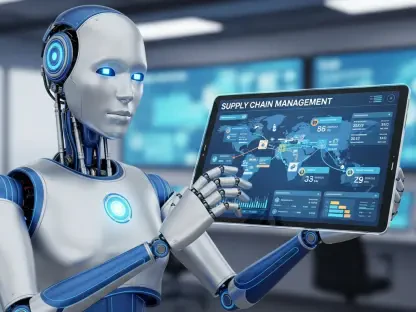Overview of AI’s Impact on Retail and Beyond
Imagine a world where the checkout line at your local store is managed not by a cashier, but by an algorithm that predicts your needs before you even reach the counter, signaling a profound shift in retail. This scenario is fast becoming reality as artificial intelligence reshapes the retail landscape, with Walmart, the world’s largest retailer by revenue, leading the charge. As a bellwether for industry trends, Walmart’s adoption of AI signals a seismic shift not just for its operations, but for the entire sector, impacting how goods are stocked, sold, and delivered to millions of customers worldwide.
Walmart’s integration of AI is already transforming key areas such as inventory management, where predictive tools optimize stock levels, and customer service, where chatbots handle inquiries with increasing sophistication. This technological leap is part of a broader movement among retail giants to stay competitive in a digital-first economy. With a global workforce of 2.1 million, Walmart’s strategies often set the tone for how labor and technology intersect, making its moves a critical indicator of what’s to come for retail employees everywhere.
Beyond Walmart, competitors like Amazon are equally aggressive in deploying AI and robotics, automating warehouses and personalizing shopping experiences at scale. The ripple effects of these advancements extend far past retail, influencing sectors like finance, where AI streamlines transactions, and healthcare, where it aids diagnostics. This cross-industry impact underscores AI’s role as a disruptive force, challenging traditional job structures and prompting a reevaluation of workforce needs across the global economy.
Current Trends and Future Projections of AI in the Workforce
Emerging Technologies and Labor Market Shifts
AI’s rapid evolution is driving profound changes in retail, with tools like generative AI creating content for product catalogs and predictive analytics forecasting consumer demand with uncanny accuracy. Automation of routine tasks, from stocking shelves to processing returns, is becoming standard, allowing companies to cut costs and boost efficiency. These technologies are not mere add-ons but are fundamentally altering how retail operates, pushing firms like Walmart to rethink their operational models.
Alongside these advancements, workforce dynamics are shifting dramatically. New roles, such as the “Agent Builder” position at Walmart, are emerging to develop AI systems that handle mundane tasks, while demand grows for skills in data analysis and machine learning. Yet, this also means traditional roles face obsolescence, creating a divide between those who can adapt to tech-driven positions and those who cannot, highlighting a pressing need for accessible training programs.
Consumer behavior is another catalyst, with shoppers increasingly expecting personalized experiences and seamless service, further accelerating AI adoption. Retailers are under pressure to meet these demands while maintaining profitability, often turning to automation as a solution. While this opens doors for growth in tech-savvy roles, it simultaneously raises the specter of displacement for workers in repetitive or manual jobs, setting the stage for a complex labor market transformation.
Market Data and Growth Forecasts
Consulting firm estimates suggest that up to 30% of retail tasks could be automated by the end of this decade, a statistic that underscores the scale of change on the horizon. This automation is expected to yield significant efficiency gains, potentially reducing operational costs for giants like Walmart. However, it also signals a substantial risk to jobs that rely on routine processes, with millions of positions globally hanging in the balance.
On the flip side, AI is poised to create net job gains in technology-driven fields, with roles focused on system development and oversight likely to proliferate. Yet, these gains may not fully offset losses in manual sectors, as industry data indicates a persistent gap in skill requirements. Projections from financial sectors, for instance, warn of up to 200,000 job cuts in global banking due to AI-driven productivity boosts, illustrating the cross-industry scope of this challenge.
Looking ahead, the economic impact of AI appears dual-natured, acting as both a job creator and eliminator. Expert analyses emphasize that while innovation will spur growth in certain areas, the pace of job displacement could outstrip creation without strategic intervention. This dichotomy presents a critical challenge for policymakers and corporations alike as they navigate the economic landscape of the coming years.
Challenges of AI Integration in the Workplace
The technological hurdles of integrating AI into existing systems are significant, particularly for a company of Walmart’s scale. Adapting legacy infrastructure to accommodate new tools often requires substantial investment and time, while employees must learn to interact with complex systems. This digital divide, especially between skilled and unskilled workers, risks widening inequality within the workforce if not addressed through comprehensive training initiatives.
Market pressures add another layer of difficulty, as Walmart faces intense competition from rivals like Amazon, who are also racing to automate operations. The drive to maintain a competitive edge can push companies toward rapid AI deployment, sometimes at the expense of careful workforce planning. Avoiding mass layoffs while implementing these changes remains a delicate balancing act, requiring innovative strategies to transition employees into new roles.
Ethical concerns further complicate AI adoption, particularly around algorithmic bias and job equity. For Walmart’s diverse, often entry-level workforce, the risk of unfair treatment through automated decision-making is real, as is the potential for unequal access to opportunities. Potential solutions include robust upskilling programs and partnerships with educational institutions to equip workers with relevant skills, ensuring that the benefits of AI are distributed more equitably across the organization.
Regulatory and Ethical Considerations in AI Adoption
Navigating the regulatory landscape for AI in the workplace is becoming increasingly complex as governments worldwide draft laws on data privacy and worker protections. These emerging frameworks aim to ensure that AI systems are deployed responsibly, safeguarding employee rights while allowing innovation to flourish. For Walmart, compliance with such regulations is not just a legal necessity but a means to build trust with stakeholders.
Ethical deployment of AI also hinges on preventing bias in automated systems, which could disproportionately affect vulnerable workers. Companies are under growing scrutiny to design algorithms that prioritize fairness, a task that requires ongoing vigilance and transparency. Industry leaders must work closely with regulators to establish standards that protect against unintended consequences of AI-driven decisions.
Advocacy from unions and worker groups adds another dimension, with calls for safeguards against sudden job displacement gaining traction. There is also a broader societal debate on measures like universal basic income or retraining subsidies to cushion the impact of automation. These discussions reflect deep concerns about AI’s potential to exacerbate inequality, urging a collaborative approach between public and private sectors to address the ethical implications of technological change.
Future Outlook: AI’s Role in Shaping Jobs and Industries
Retail is on a trajectory toward greater automation, with certain functions like warehousing and checkout processes potentially becoming fully AI-driven in the near future. Walmart’s strategies in this space could serve as a blueprint for how to scale such technologies while managing workforce impacts. The broader implications for related sectors suggest a reshaping of industry structures, as businesses adapt to a landscape dominated by digital efficiency.
Emerging disruptors, including advanced robotics and machine learning, are set to redefine job roles even further, with implications for both operational and customer-facing positions. These technologies could streamline complex tasks, but they also raise questions about the long-term viability of human labor in certain areas. Keeping pace with such innovations will be crucial for companies aiming to maintain relevance in a rapidly evolving market.
Consumer preferences for tech-driven experiences, such as personalized recommendations and instant service, are likely to accelerate AI adoption in retail. Coupled with global economic conditions and the pace of innovation, these shifts could dictate how quickly industries transform. Walmart’s “flat headcount” strategy, aiming for workforce stability amid change, offers a test case for balancing growth with human capital, potentially influencing global approaches to AI integration.
Conclusion: Balancing Innovation with Workforce Stability
Reflecting on the insights gathered, it becomes evident that AI holds transformative power, capable of redefining efficiency while posing real risks of job elimination, as Walmart CEO Doug McMillon has cautioned. His perspective sheds light on a critical tension within the industry, where technological progress often outpaces workforce readiness. Walmart’s efforts to maintain stability through training and role evolution stand out as a commendable attempt to navigate this challenge, offering lessons for other sectors.
Looking back, the exploration of AI’s dual nature as both creator and eliminator of jobs highlights the urgency of proactive measures. Moving forward, stakeholders should prioritize investments in upskilling initiatives to bridge skill gaps and ensure workers can adapt to new demands. Fostering public-private partnerships emerges as a vital step to develop inclusive policies that support equitable growth.
Ultimately, the path ahead demands a commitment to ethical guidelines in AI deployment, ensuring fairness and transparency remain at the core of innovation. By focusing on collaborative solutions, such as accessible education programs and robust regulatory frameworks, industries can mitigate the risks of displacement. This balanced approach promises a future where technology amplifies human potential rather than diminishes it, setting a sustainable course for progress in an AI-driven era.









